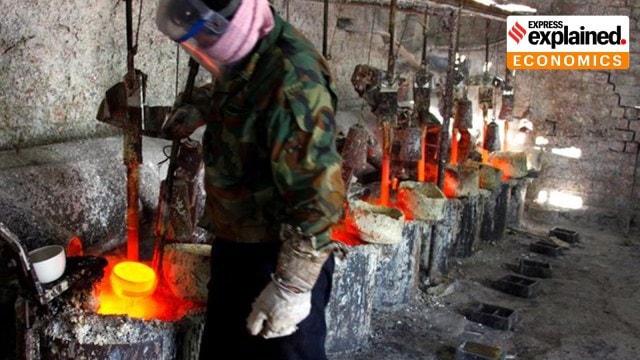China restricts exports of rare earths: What will be the impact?
Given China’s dominance in rare earths mining and refining, and their uses ranging from making smartphones to defence equipment, major repercussions could follow.
 A worker at the Jinyuan Company's smelting workshop prepares to pour the rare earth metal Lanthanum into a mould near the town of Damao in China's Inner Mongolia Autonomous Region, in this file picture. (Photo: Reuters)
A worker at the Jinyuan Company's smelting workshop prepares to pour the rare earth metal Lanthanum into a mould near the town of Damao in China's Inner Mongolia Autonomous Region, in this file picture. (Photo: Reuters)China announced restrictions on the export of seven “rare earths” on April 4, soon after US President Donald Trump decided to impose tariffs on most of the country’s trade partners earlier this month.
These elements are crucial for manufacturing high-value goods, including in the fields of defence and clean energy, as well as everyday items like smartphones and electronic displays. Since the 1990s, China has held an unrivalled dominance over rare earths, supplying 85 to 95 per cent of the world’s demand.
Several shipments of rare earths have come to a halt in recent days, sources told Reuters. Amid a rapidly changing global trade landscape, several Western media reports have warned that prolonged delays and restrictions could have major repercussions for multiple industries. Here is what to know.
What are rare earths?
Rare Earth Elements or Rare Earth Metals are a set of 17 chemical elements in the periodic table — cerium (Ce), dysprosium (Dy), erbium (Er), europium (Eu), gadolinium (Gd), holmium (Ho), lanthanum (La), lutetium (Lu), neodymium (Nd), praseodymium (Pr), promethium (Pm), samarium (Sm), scandium (Sc), terbium (Tb), thulium (Tm), ytterbium (Yb), and yttrium (Y). All have similar chemical properties and appear silver-coloured.
According to the United States Geological Survey (USGS), most REEs are not as rare as their name suggests. “They were named “rare-earth elements” because most were identified during the 18th and 19th centuries as “earths” (originally defined as materials that could not be changed further by heat) and in comparison to other “earths,” such as lime or magnesia, they were relatively rare.”
While nearly all REEs are more abundant on average in the Earth’s crust than silver, gold, or platinum, it is unusual to find concentrated and economically mineable deposits. China holds expertise in the refining of rare earths more than any other country.
Ironically, even as REEs are being used to build electric vehicles and wind turbines, all part of the push for “clean energy”, their mining process results in significant environmental damage. For instance, rare earth ores contain arsenic and cadmium, which are allowed in the open air during the refining process. These elements can harm human health and contaminate water sources.
However, REEs’ unique magnetic and optical properties lend them to a multiplicity of uses, including making phosphors, or substances that emit luminescence, for making digital displays and screens. Increasingly, REEs are being used to build powerful magnets, with uses in parts of automobile manufacturing — power steering, electric windows, power seats, and audio speakers.
Why has China restricted rare earth exports?
Ores of rare earth oxide are found in China, Russia, the United States, India, and Australia (in descending order), but China dwarfs others in production and refining.
REEs have been found across China, such as in the Jiangxi and Guangdong provinces in southeast China, Hubei in central China, Sichuan in the southwest, and the Xinjiang autonomous region in the northwest.
In the 1990s, China’s government declared rare earths to be a “protected and strategic mineral”. Since then, it has periodically ordered restrictions on their extraction based on changing domestic and global demand, as well as during disputes with other countries. In 2010, following Japan’s detention of a Chinese fishing trawler captain, rare earths exports were blocked for some time.
In 2022, China threatened to stop exporting rare earth materials to the US amid the trade war between the countries during the first Trump administration.
This time, China’s Ministry of Commerce (MOFCOM) and the General Administration of Customs (GAC) announced export controls on seven rare earths — samarium, gadolinium, terbium, dysprosium, lutetium, scandium, and yttrium. This was “to better safeguard national security and interests and fulfill non-proliferation and other international obligations,” according to a MOFCOM spokesperson.
What happens now?
According to The New York Times, existing stocks of REEs vary among sectors, so it is difficult to estimate when the effects will really be felt. The Economist noted that China’s central role in the sector means notable impacts would become visible soon enough. “Prices would rise fast, as buyers began to stockpile. Neha Mukherjee of Benchmark Minerals, a research firm, reckons dysprosium prices would hit $300 per kilogram, from $230 now,” it noted.
Many of the restricted REEs, such as Dysprosium, are also hard to replace but have critical end-use, including in magnets that power offshore wind turbines, jets and spacecraft.
Ultimately, other sources would have to be tapped. For instance, during the 2010 dispute, Japan quickly moved to stockpile REEs, develop and acquire mines in countries such as Australia, and promote their recycling. According to the World Economic Forum, this resulted in its dependence on Chinese rare earths dropping from 90% at the time to 60% in 2023. This is still a high share, but the response showed an attempt to diversify and reduce vulnerability even in a lopsided market.
Such a strategy has been echoed in concepts like “de-risking”, which argue for diversifying supply chains away from China while maintaining trade relations with it. Increasing globalisation in recent decades makes this complicated, but the ongoing tariff war has underlined the need for it.
Concurrently, several Western analysts believe that years of investments in critical industries, alongside the promotion of science and tech education, have allowed China to get around US restrictions. Despite reports of a slowing economy and demographic challenges in recent years, there is room for optimism in China thanks to products like the AI Large Language Model DeepSeek. “It has been taken as a sign that the country can innovate around America’s semiconductor embargoes,” a report from The Economist said earlier in April.
Thomas L Friedman, renowned author and political commentator, also noted the case of Huawei in an opinion article for The NYT this year. Even in the face of US export restrictions imposed in 2019 on the Chinese tech giant over security concerns, it has registered growing revenue and created innovative products.
More Explained
Must Read
EXPRESS OPINION
Apr 24: Latest News
- 01
- 02
- 03
- 04
- 05




























